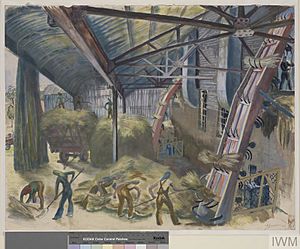Nora Fry Lavrin facts for kids
Quick facts for kids
Nora Lavrin
|
|
|---|---|
| Born | 1897 |
| Died | 30 August 1985 (aged 87–88) London, United Kingdom
|
| Nationality | British |
| Education |
|
| Known for | Engraver, book illustrator, painter |
Nora Lavrin (born Nora Fry, 1897 – 30 August 1985) was a talented English artist. She was known for her engravings, illustrating books, and painting. Nora illustrated twenty different children's books during her career.
Early Life and Art Training
Nora Fry was born in Liverpool, England. Her father, Ambrose Fry, was from Canada and managed properties and made chemicals. Her mother, Lydia (Lily) Thompson, came from the Shetland Isles. Nora's brother, the famous architect Maxwell Fry, wrote in his book that their mother played the piano and painted. Nora had an older sister, Muriel, and two younger brothers, Edwin Maxwell and Sydney.
Nora and her sister Muriel both studied art at the Liverpool School of Art. In 1920, Nora won a special scholarship that allowed her to travel. She spent a year in Paris, France, attending the Académie de la Grande Chaumière, a famous art school. She also traveled around the French countryside, especially in a town called Semur-en-Auxois, where she made many drawings and watercolors.
Nora started her career illustrating children's books in 1926. Her first job was creating designs for The Little Grey Men of the Moor by Betty Timms. In 1927, she illustrated two more books that became very popular. Her pictures for Aesop’s Fables (1927 and 1934) were used in eight different editions over many years. She also illustrated A Treasure of Tales for Little Folks (1927), which was reprinted several times in the 1930s.
In September 1927, Nora joined the Engraving School at the Royal College of Art (RCA) in Kensington. There, she focused on engraving and etching, learning from the artist Robert Austin. Nora finished her studies at the RCA in July 1928, earning a certificate in etching.
In July 1928, Nora Fry married Janko Lavrin. He was a professor who studied Slavic languages at Nottingham University College. Her marriage introduced her to the countries of Slovenia and Yugoslavia. She created beautiful dry point landscape sketches of these places, which were published in Slovenia Summer (1928) and Yugoslav Scenes (1935). Nora and Janko had two sons: John Lavrin, who became a painter, and David H. Lavrin, who became an immunologist.
From 1935 to 1937, Nora worked as an art teacher at the University College of Nottingham. Throughout the 1920s and 1930s, her artwork was shown in many exhibitions. These included the Royal Academy Summer exhibition and shows in Liverpool and Nottingham. Later, in 1961, her work was also shown in Ljubljana, Slovenia.
World War II Contributions
During World War II, Nora and Janko Lavrin lived in London. While Janko worked for the BBC World Service, Nora continued to teach art. She taught at several art schools, including the Hammersmith School of Art, which stayed open during the war.
Nora also spent time outside London, drawing and painting the important work done by the Women's Land Army. These brave women helped with farming and food production while many men were away fighting. Several of Nora's artworks showing the Land Girls were bought by the War Artists' Advisory Committee. These pieces are now kept at the Imperial War Museum, showing a valuable record of wartime life.
During the war, Nora continued to illustrate books. These included Averil Demuth's Trudi and Hansel (1938) and Hilda Lewis's The Ship that Flew (1939, reprinted in 1986). She also illustrated several books by Elisabeth Kyle, such as The Seven Sapphires (1944), Holly Hotel (1945), Mirror of Castle Doone (1947), and Lost Karin (1947).
Later Career and Legacy
After World War II, Nora Lavrin continued to illustrate many books. She worked on books about Slovene literature, like An Adder’s Nest (1931, 1943) and Ivan Cankar’s The Bailiff Yerney and his Rights (London 1946). She also illustrated The Ward of Our Lady of Mercy (Slovenia 1976) and Matej Bor’s A Wanderer in the Atomic Age (1967 and 1970).
Nora also illustrated Slovene translations of famous English books. These included Villette by Charlotte Brontë (Ljubljana 1965), The Tenant of Wildfell Hall by Anne Brontë, and several novels by Thomas Hardy like The Return of the Native, Far from the Madding Crowd, and The Mayor of Casterbridge.
In 1952, Nora published a book called The Hop Dog with Molly Thorp. This story was later made into a children’s film called Adventure in the Hopfields (1954). Nora was also very interested in ballet. She designed sets and costumes for a ballet called Love and Litigation in 1956. She even made sketches of the famous Ballet Russe when it toured England in the 1930s.
During the 1950s, Nora Lavrin created many portrait sketches of everyday life. Her oil paintings of landscapes and watercolor portraits of her children and family are mostly held in private collections. The Ashmolean Museum in Oxford has a collection of her original illustrations. Her work is also displayed at the Maribor Art Gallery in Slovenia. Her dry points of Yugoslavia, published in 1935, are very important. They show the landscapes and people of a region that changed a lot after World War II, giving us a historical look at that time.


